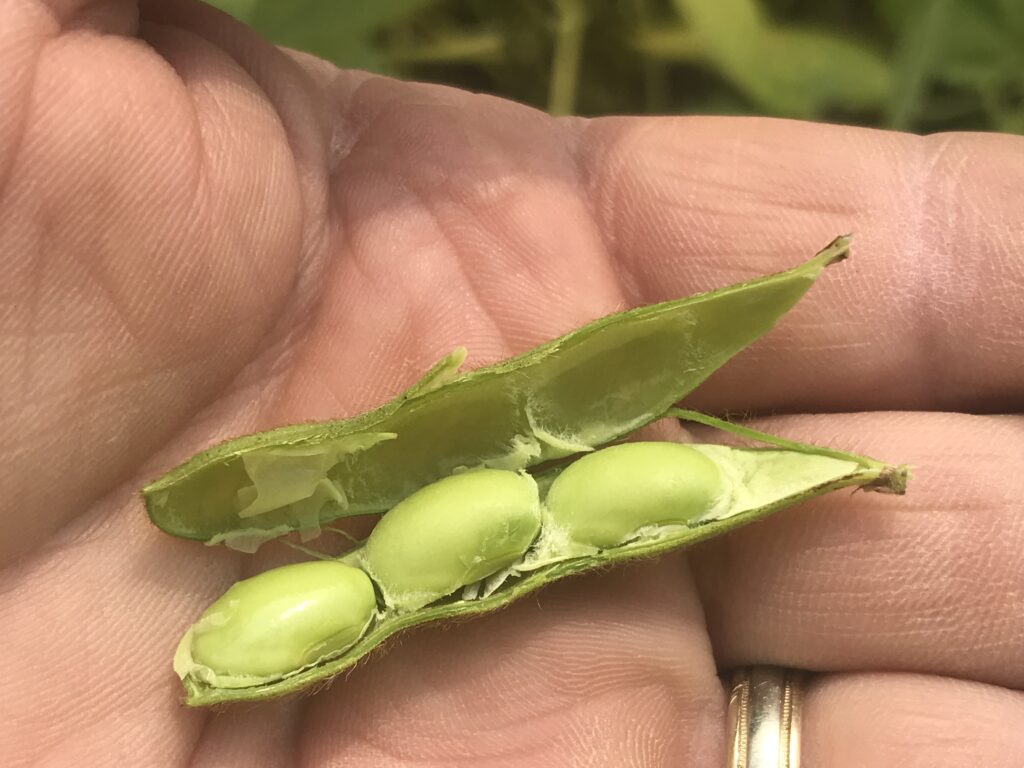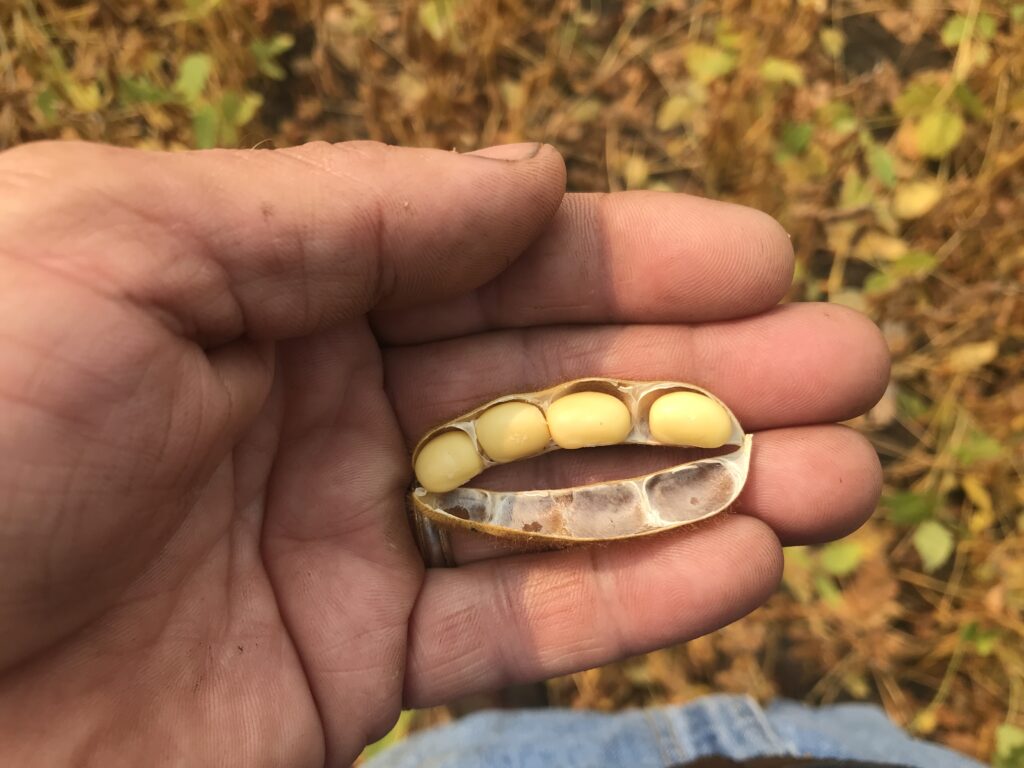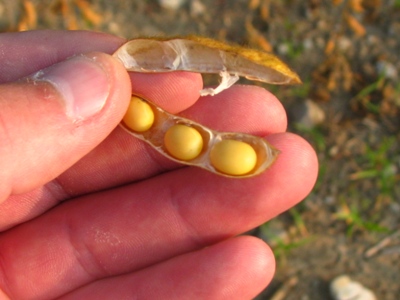co-written by Horst Bohner
A pre-harvest herbicide treatment can make harvest more efficient when there are an unacceptable number of weeds in a soybean crop. Both conventional and glyphosate tolerant fields that are weedy can benefit from a pre-harvest herbicide. Drier plant matter will pass more easily through the combine, lowering seed losses and reducing seed staining. Appropriate product selection for the target weed species and application timing are important for the success of any pre-harvest application.
Pre-harvest herbicides do not speed up how fast soybeans mature, nor make soybean seed dry down faster. But they will speed up harvest timing by 1-3 days because remaining leaves will drop more quickly, and green material will dry up. Green tissue will be killed such as leaves, stems, or pods on soybeans, but green seed does not dry down more quickly. Crop quality often increases because the harvest timing after the field has been sprayed is more predictable, and therefore harvest schedules can be better managed. Most importantly a pre-harvest burndown will dry down weeds, making combining easier and cleaning up the field for winter wheat planting.
What are the target weed species?
If perennial weeds are the target, glyphosate is the preferred product because the shorter days and cooler temperatures that occur in the fall act as a trigger for perennial weeds to reallocate sugars to their roots for over-winter storage. Applying glyphosate in the fall promotes movement of the active ingredient down to the roots, providing more effective control of Canada thistle, perennial sow thistle, field Bindweed and dandelion.
IMPORTANT NOTE: Contact your buyer to verify what pre-harvest products are acceptable to use. Glyphosate is not allowed in some food grade soybean (e.g. non-GMO) contracts.
If annual weeds are the target, glyphosate will still be effective but the speed of activity is slow compared to other pre-harvest options such as Aim (carfentrazone), Eragon LQ (saflufenacil) and Reglone (diquat). Therefore glyphosate is often tank-mixed to provide broad-spectrum activity but with increased speed of activity on broadleaf weeds in particular. It is generally not recommended to mix one of the fast acting pre-harvest options with glyphosate if perennial weeds are the primary target. This is because their ability to quickly burn leaf tissue can sometimes impede translocation of glyphosate within a perennial plant.
Application Timing
Application timing is critical. Do not spray too early. If application occurs early yield losses can occur, and chemical residues will be taken into the seed. Herbicide residues in the harvested seed will result in marketing problems. If large patches of soybeans in the field remain green, it will be necessary to wait for those areas to mature before spraying. It is safe to spray when seed fill is complete. This can be determined by a colour change of the seed from green to yellow. A change in colour of the pods is an excellent indicator that the seed has also changed colour. Since the colour change of the pods is gradual, it may be difficult to determine when the pods have truly “changed” from green to yellow or brown. A change in colour is defined by the absence of any green colour left on the pod. At least 90% of the pods need to have changed colour and no longer contain any green. This stage of the crop typically occurs when there is at least 80% leaf drop, although a field should not be assessed by leaf drop alone. See Figure #1. Pod colour change is the best indicator for when to spray.

Another way to assess if the field is ready is to determine if the seed has separated from the pod. Once the seeds turn yellow, the next visual change is that the seeds start to shrink inside the pod and separate from the white membrane inside the pod. Figure #2 shows seed that has not detached from the pod and still has some green colour. This field should not be sprayed.

Once the seed has detached from the pod as in Figure #3, the seed is considered mature and the field can now be sprayed. This test is most accurately done by collecting random pods from the top one third of the plant. If all the seed has separated from the pod, then the crop has reached physiological maturity and can be sprayed.

Typically pods from the bottom of the plant actually look like they are ready to be thrashed and have started to dry down. See Figure #4.

Pre-harvest intervals
For glyphosate, a 7 day pre-harvest interval must be followed. Eragon LQ has a 3 day interval, although typically the field is ready to harvest at 7 to 10 days after application because the weeds have had more time to dry down. If a tank mix is applied, you must use the longest pre-harvest interval of the products used (7 days if glyphosate and Eragon LQ are tank mixed).
The following products can be used for pre-harvest applications in soybeans. Use products based on the label rates and with the recommended water volumes.
IMPORTANT NOTE: If you are harvesting food grade soybeans (e.g. non-GMO) for the export market, there may be restrictions on what pre-harvest herbicides you can use. Contact your buyer to verify what pre-harvest products are acceptable to use.
1. AIM EC at 47 mL/acre + non-ionic surfactant at 0.25% v/v
-
- The pre-harvest interval for this product is 3 days.
2. REGLONE at 0.68 L/acre + AGRAL 90 at 0.1% v/v
-
- Apply within 7 days of variety maturity and harvest 5-7 days after application.
- Several generic versions of Reglone (diquat) are available in Ontario.
3. GLYPHOSATE at 0.67 L/acre (540 g/L))
-
- Apply when the crop is 30% grain moisture or less.
- Do not apply to crops being grown for seed, as glyphosate can negatively effect seed germination.
- Apply at least 7 days prior to harvest.
4. ERAGON LQ at 60 mL/acre + Merge at 400 mL/acre
-
-
- Apply when stems are green to brown in colour and pods are mature (yellow-brown) and 80-90% of the original leaves have dropped.
- The pre-harvest interval for this product is 3 days.
- Tips to improve performance: 1) Increase carrier volume to 250 L/ha (100 L/acre) of water; 2) Apply during the warmest part of the day and ideally when humid and sunny,
3) Avoid applications during cloudy, overcast conditions and 4) Use nozzles that deliver a medium to coarse droplets
Comparative studies in Ontario
There is limited public research comparing performance of pre-harvest treatments on different weed species. Dr. Peter Sikkema has conducted four trials from 2010 to 2011 on edible beans and his results are summarized below. Regardless of treatment used, the expectation should be that the pre-harvest treatment will improve harvest efficiency but it will not result in a complete “dry down” of target weeds.
-
Table 1. Visual Control (%) of lamb’s-quarters, ragweed, pigweed and foxtail at 8 days after application of various dessicant treatments.
* glyphosate rate per acre is based on a product concentration of 540 g/L (e.g. Roundup Transorb, Credit Extreme)treatment (rate/ac) lambsquarter ragweed pigweed foxtail glyphosate (1 L/ac)* 32 20 38 62 Reglone (0.92 L/ac) + Agral 90 (0.1% v/v) 74 80 78 48 glyphosate (0.67 L/ac)* + Aim EC (47 mL/ac) + NIS1 (0.25% v.v) 39 25 50 64 glyphosate (0.67 L/ac)* + Eragon (60 mL/ac) + Merge (0.5% v.v) 49 72 66 65 glyphosate (0.67 L/ac)* + Reglone (0.92 L/ac) + Agral 90 (0.1% v.v) 70 77 76 49
1 NIS = Non ionic surfactant (numerous products/trade names are available)
Source: Dr. P. Sikkema, 4 Trials: DB10D1A, DB10D1B, DB11D1A and DB11D1B. Weed Control Trials Research Report, 2010- & 2011. University of Guelph, Ridgetown Campus.